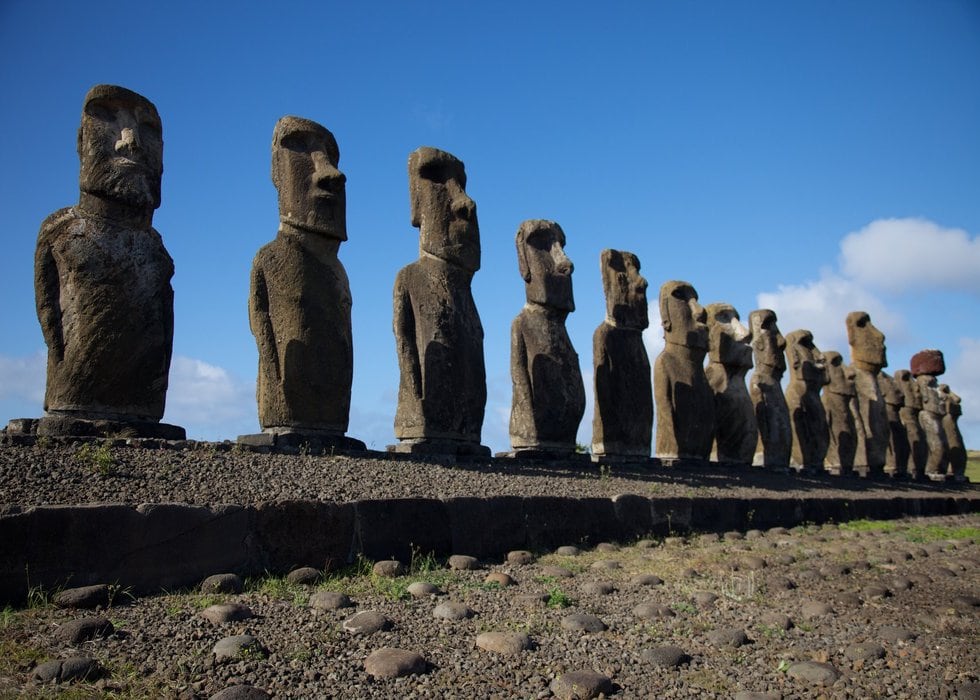One of the remotest and most isolated islands in the world, Easter Island is located some 2,300 miles (3,700 km) west of South America and 1,100 miles (1,700 km) from the nearest neighboring island. With a total area of just 64 square miles (166 square km), this tiny speck in the middle of the Pacific Ocean is smaller than the Federal district of Washington! As the saying goes, ‘good things come in small packages’, Easter Island with its Rapa Nui National Park certainly does not disappoint! After visiting and seeing the beauty and unique culture of this Chilean Island, we could not help ourselves but begin to put together incredible tours for you. So, now that you know we offer luxury tours to this not-to-be-missed island, you might begin to ask what there’s to see and do as well as wanting to find out some information about the Island. Well don’t fret, we’ve got that all covered in this blog article as we take a look at this gem in the Pacific Ocean.
A (quick) brief one-stop history of Easter Island
Settled by Polynesians over 1,000 years ago, Rapa Nui was inhabited by a wholly Stone Age society. According to Island traditions, the colonizing expedition comprised of 50 people, in two canoes that were being led by King Hotu Matu’a. Following on between the 10th and 16th centuries, the islanders began expanding across the island, setting up small settlements along the coastline. It was during this time that the famous Moai statues were constructed which showed the advances and high cultural level of this society. Many years later on Easter Sunday 1722, (key to its namesake) the island was discovered by chance by Jacob Roggeveen, giving Rapa Nui, the European name of Easter Island. In 1888, Chile annexed the island believing it had strategic and economic potential and finally in the 1960’s, Easter Island gained its current states as a department within the Chilean province of Valparaiso. In 1995, Easter Island was named a UNESCO World Heritage site with the majority of the land protected within the borders of the Rapa Nui National Park. Today the population of the Island is believed to be just over 5,700 with more than half of the inhabitants being descendants of the native Rapa Nui.
Sunrise at Ahu Tongariki / Source
When’s best to go?
The subtropical climate of Easter Island is strongly influenced by the winds and ocean currents. The hottest months to visit are January and February making them perfect to explore the Moais on Anakena beach, and the coolest months are July and August which are ideal for hiking. The average maximum summer temperature is 28°C although this certainly underestimates the strength of the fierce sun and formidable heat. If the heat is not for you, the average winter maximum is 22°C, but it can seem much cooler if the Antarctic winds decide to pay the Island a visit. The weather is pleasant on the Island all year round meaning you can take advantage of the highlights of Easter Island, its natural beauty and interesting culture whenever you are free to do so!
Highlights of Easter Island:
Seeing the famous Moai Statues
The interesting Moai statues which feature in most coffee table books with photographs from around the world can be found scattered around the island. No vacation to Easter Island would be complete without going to see these culturally and historically significant statues within the Papa Nui National Park. Make sure to visit the few that remain standing at Ahu Tongariki, where 15 Moais stand powerfully in a military line with their backs to the sea, watching over the inhabitants of the island. More historical information, interesting facts and their significance for the native Rapa Nui will be revealed in our second blog article on Easter Island later on this week…so stay tuned!
Anakena Beach Moai Statues / Source
The Natural Beauty of Easter Island & Anakena Beach
Even though, the Moai get most of the attention when visiting Easter Island, this exotic, Polynesian Island also has an abundance of natural beauty for you to make the most of. The waters surrounding the island are full of vibrant, colorful marine life as well as some marvelous underwater stone structures. All of these can be enjoyed whilst snorkeling or diving into this exotic bucket list location. For those that want to make the most of the Islands beaches, then you should pay a visit to Anakena beach which can be found at the northernmost part of the island. Anakena beach is quite different from any other beach you will visit! Although it has golden sand, calm turquoise water and palm trees creating the picture perfect exotic beach location, you won’t be able to help yourself but notice the large, dominating Moai that stand proudly with their backs to the ocean.
Easter Island’s beautiful Anakena Beach / Source
Make sure not to miss our blog later this week which will explore the fascinating and attention-grabbing Moai statues. Also check out our new Easter Island tours and Easter Island extension packages which complement any vacation to Chile and South America.
Thanks for visiting our South America Travel Blog! Feel free to contact one of our Travel Specialists via email, phone or chat to plan your perfect Easter Island itinerary.
